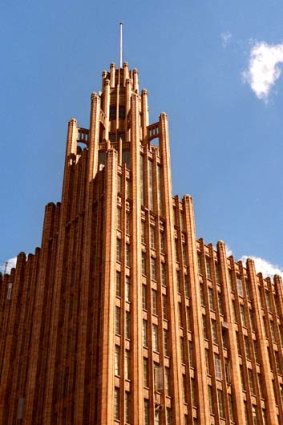
Mancunian impression ... the Depression-era Manchester Unity Building.Credit: Mario Borg
Tim Richards takes a trip down art deco memory lane.
"WHAT they wanted was simple elegant lines," Robin Grow says as we gaze up at the soaring exterior of the Manchester Unity Building, and it seems as if he's neatly summed up art deco in a few well-chosen words.
On the Melbourne Art Deco Architecture Tour he leads, we have the 19th-century Melbourne Town Hall at our backs and the 20th-century glory of the Manchester Unity Building before us. You couldn't ask for a better contrast between the two eras, with the MUB's straight lines disdaining the flounces of its ancestor across the street.
"Art deco represents a real turning point in Melbourne's story of revival in the 1930s, using architecture and new design as a way of boosting the economy at the time," says Grow, also president of the Art Deco & Modernism Society.
The star exhibit of this Depression-busting style was the Manchester Unity Building, which gave much-needed work to labourers as it was swiftly constructed in 1932. Within its foyer there's a collection of grand ornamentation; one frieze depicts an Aboriginal man carving a canoe while being watched by a kangaroo.
Elsewhere, there are trademark deco touches such as sunburst patterns and zigzag lines. Decorative panels high on the walls feature near-nude figures that resemble those of Ancient Greek statues, though oddly married with modern objects. In one, a barely clad chap is handing over a bag marked with a big "£" symbol in exchange for a 1930s-style house.
Having drunk our fill of the MUB and the neighbouring Capitol House, we're off to discover some lesser-known art deco gems. As we walk, I ask Grow why deco has remained so popular over the decades since it shot to fame at a 1925 exposition in Paris.
"People are attracted to various elements within it," he says as we head along Collins Street.
"The colour, the simplicity, the lines. The other thing of course is finding small details on buildings. Often they're little signatures about who was in the building, who designed it etc, and that can be really fun."
I see what he means as we pause beneath the lavish mosaic that decorates the front of Newspaper House, where Melbourne's The Herald newspaper was once produced. Behind a figure blowing a long horn are images of modern technology, including cars, trains and planes. The speed with which the media sends news around the world in the modern age is summed up by a Shakespeare quote above the entire composition, "I'll put a girdle round about the Earth".
"Communications, radio, telephone, cars, planes, boats; all of these things were changing the way people saw the world," Grow says.
"They also represented the fact that the world was shrinking in lots of ways, particularly through the medium of radio, which brought it closer together."
There are more delights for us to see along Collins Street - Kodak House, the Royal Bank building and the now-truncated Block Court arcade which used to connect with Block Arcade. Its floor contains some terrazzo designs that are still as colourful as they were in the 1930s.
Around the corner we admire the attractive simplicity of Yule House with its distinctive "speed lines", then arrive in Bourke Street Mall to be served a feast of deco styling. The Myer building and the former Coles store are impressive above street level, and our guide also draws our attention to three figures depicted at the top of the former Buckley's menswear store: one out walking, one playing golf, and one in dinner suit holding a pink cocktail.
Of the remaining items on the tour, the stand-out is a former bank building on Bourke Street that features an Ancient Egyptian flying sun-disc at its top. It's an unusually comely home for the convenience store at ground level.
"There's no need to knock them down," Grow says. "They can all be converted, with a bit of work to introduce new technology and make them comply with current codes. Once you've done that, you've got a wonderful example of a building from another era that works in today's era as well."
The MELTours Melbourne Art Deco Architecture Tour takes place on the second Sunday of each month. Cost $49. Bookings on 0407 380 969 or meltours.com.au.
Sign up for the Traveller Deals newsletter
Get exclusive travel deals delivered straight to your inbox. Sign up now.